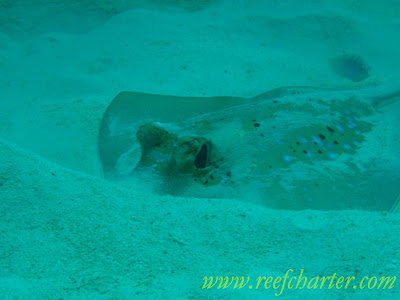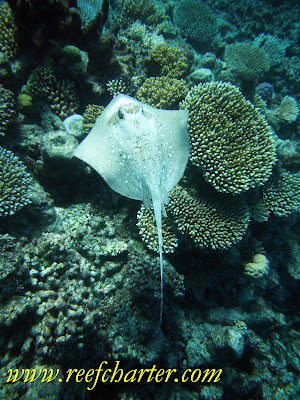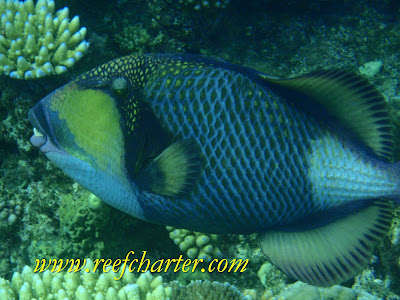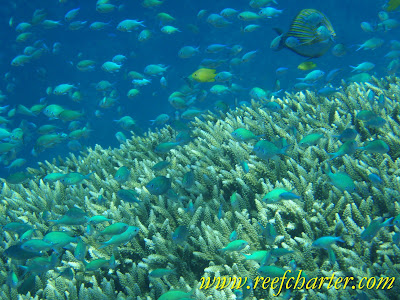Another common site on the reef is the blue spotted ray. The blue spotted ray is found behind the reef face in the sandy bottom. It often buries itself in the sand, as seen above, so only its eyes appear above the surface of the sand. Being bottom feeders, their mouth is perfectly designed to scoop crabs, shrimp and fish. Instead of chewing its mouth is designed for a crushing motion rather then chewing before swallowing it’s meal.
The average blue spotted ray is about 30cm (12 inches) across the back. It is most commonly seen in depths ranging from about 6m – 20m. Sometime seen gracefully swimming over the coral beds on the reef as the photo below shows.
The male fertilizes the eggs inside the female where they remain, yes inside the eggs and inside the mother, until they hatch and she gives birth to live rays, known as pups.
Category: Fish
Trigger Fish – Balistidae
Triggerfish derive their common name from a stout first dorsal spine which can be locked into potion by a small second spine, looking like a trigger. The trigger is used by the fish to wedge themselves into coral crevices at night. They come in a variety of beautiful colors and patterns, making them something to behold. These fish are also characterised by a leathery skin and a small mouth with powerful, crushing jaws. But don’t worry they do not are not looking to you for a meal. However, sometimes they guard their nest as we guard our homes. Triggerfish feed on a wide variety of invertebrates including sponges, gorgonians, crabs, shrimps, molluscs and echinoderms. They are often seen head down ‘blowing’ water into the sand to excavate food. They swim by undulating the second dorsal and anal fins, bringing their tail into action only when speed is needed.
Damsel Fish – Species of the Reef
No one ever talks about the poor old damsel fish. But they are very important in the reef ecosystem, eating algae allowing for reef regrowth. Damselfish are one of the most abundant groups of coral reef fishes. They display remarkable diversity in habitat preferences, feeding habits, behaviour and colouration. Most species are highly territorial. Algal-eating species zealously defend their ‘plot’ against intruders, regardless of size. These algal feeders. These algal feeders generally have drab colour patterns whereas the plankton-feeding damsels are brightly coloured. Damselfish eggs are laid on coral rock and are guarded by the male until they hatch in 2-14 days. All damselfish, except the anemonefish (genus Amphiprion and Premnas), change sex from male to female. The anemonefish goes through a reverse sex change from male to female.
Why are fish so brightly coloured?
‘Why are fish so brightly coloured?’ This is one of the questions most commonly asked by our guests.
Reef fish are able to see colour. Their bright colours are important in species recognition and in the determination of sex. Some species, such as angelfish, have juvenile patterns that are totally different to the adults. The different colour patterns of juveniles may prevent adults from seeing them as a potential threat to territories or as reproductive partners. They also use their colours to blend with the environment is an import way to ambush prey and to hide from predators.



